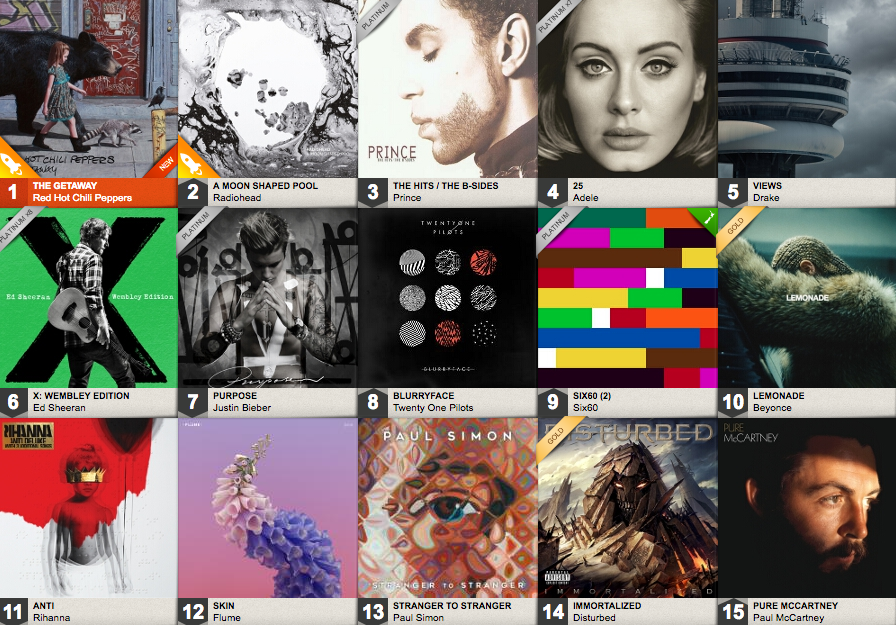How many streams doth an album sale make? Recorded Music NZ thinks it has the answer

Album charts have traditionally been determined by the number of sales made on a weekly basis, but earlier this month Recorded Music New Zealand added on-demand streams into the equation.
Recorded Music chief executive Damian Vaughan says this change has already been effected when it comes to the singles charts and that extending to the album chart is in line with music consumption habits shifting online (this observation is substantiated by Nielsen CMI data).


He says the charts now provide a total view of what Kiwi consumers are listening to.
The process of normalising the data from disparate data sources into a single unit isn’t as easy as adding the numbers together. The value afforded to an album purchase will invariably carry more weight than a single stream.
So exactly how much more weight should an album purchase have?
Vaughan says that the single chart is formulated on a ratio that sees the purchase of a single equated to 175 streams.
“The ratio of 1:175 is a standard international calculation that we use to accurately reflect the value differential between sales and streams in New Zealand,” Vaughan says.
“We actively monitor this conversion ratio and adjust if it is no longer accurate.”
Vaughan says this ratio was first introduced to the singles chart in late 2014 and, although Recorded Music NZ monitors it closely, it has not yet been updated.
“As reference the UK and Australia use the same calculation but their ratios are slightly different,” Vaughan says.
The process of quantifying the purchase to a stream is complex enough, but the waters are muddied even further when attempting to develop a consolidated measurement methodology for album data.
“It’s a tad complicated,” Vaughan explains in referring to the three-step methodology that was launched on 17 June this year.
The full explanation offered by Vaughan is as follows:
“1. The two tracks attracting most streams are reduced to the level of the average of the next eight highest streamed tracks associated with the album (or all tracks where an album has fewer than ten tracks). This ensures that albums with one or two hit singles do not distort the performance of an album within the albums chart.

2. When establishing the revised streams for neutralised tracks from an album, the average streams applied to neutralise tracks will be based on streams linked to the eight single products in the calculation.
3. After the methodology above is applied, the streams of the top ten tracks (or all tracks where an album has fewer than ten tracks) making up the album are aggregated together and converted using the audio conversion rate established for the singles 1:175 and the widely used rate of ten tracks = one album.”
Vaughan says there haven’t been very marked changes in the charts since the new methodology launched last week, but he says there have been a few shifts in genres such as dance and urban, which are skewed heavily in favour of streaming.
Broader relevance
The consolidation of consumer data sets across a range of channels is also becoming an important issue in media at a time when advertisers are becoming increasingly comfortable buying audiences rather than slots.
TVNZ’s Jeremy O’Brien has been one of the most vocal proponents of fusing its online and linear audiences into a single data set, so that advertisers are able to buy ads across all available channels instantly.
“We are currently working with the industry to introduce a move to CPM trading,” O’Brien recently said in an interview with NZ Marketing.
“We think TV efficiency should be measured the way online is now: cost per 1000 impressions.”
Because of the complexity involved and the investment required, TVNZ isn’t acting independently to make it happen. The initiative is being driven at an industry level, with MediaWorks acting chief executive David Chalmers saying that he also supports the move.
Part of the reason why the TV industry is so interested in making this happen is because the channel still commands enormous scale, not only on free-to-air but also through its on-demand services.
All this comes at a time of enormous growth in programmatic ad buying, which is tipped to become the preferred method of trading in the future.
And programmatic ad buying isn’t only limited to online advertising. As indicated by O’Brien’s intentions, television is quickly moving in this direction. And with its investment in digital sites, outdoor is also headed in this direction (outdoor is already being sold programmatically in Australia).
What’s more is the print industry has also started dabbling in this space, with Time magazine selling its print ads programmatically in the United States.
So is the same likely to happen in the magazine industry in this market?
For now, Tangible Media chief executive John Baker does not see this as likely.
He says that reading a magazine remains very different from browsing a website online, and he does not believe that these two experiences should be conflated into a single audience-based metric.
He says this would be tantamount to commoditising the magazine audience, and would detract from the value that comes in the shape of a reader willing to pay for something.
Doing this in the music industry is, of course, quite different, in that the charts are simply a reflection of what is performing well, rather than an integral part of the industry’s revenue structure.
For now, a major point of difference for the magazine industry lies in the high engagement of its audience—and this is not something media owners would be willing to sacrifice anytime soon.
That said, media is turning into a big melting pot. And as the channels meld together, it looks increasingly likely that the discrete data sets will eventually do the same.




